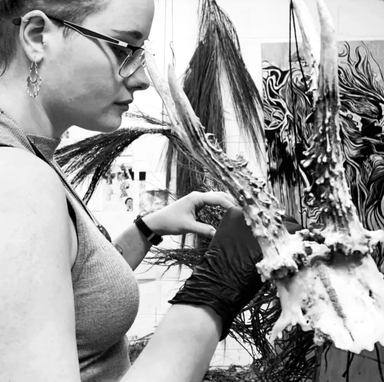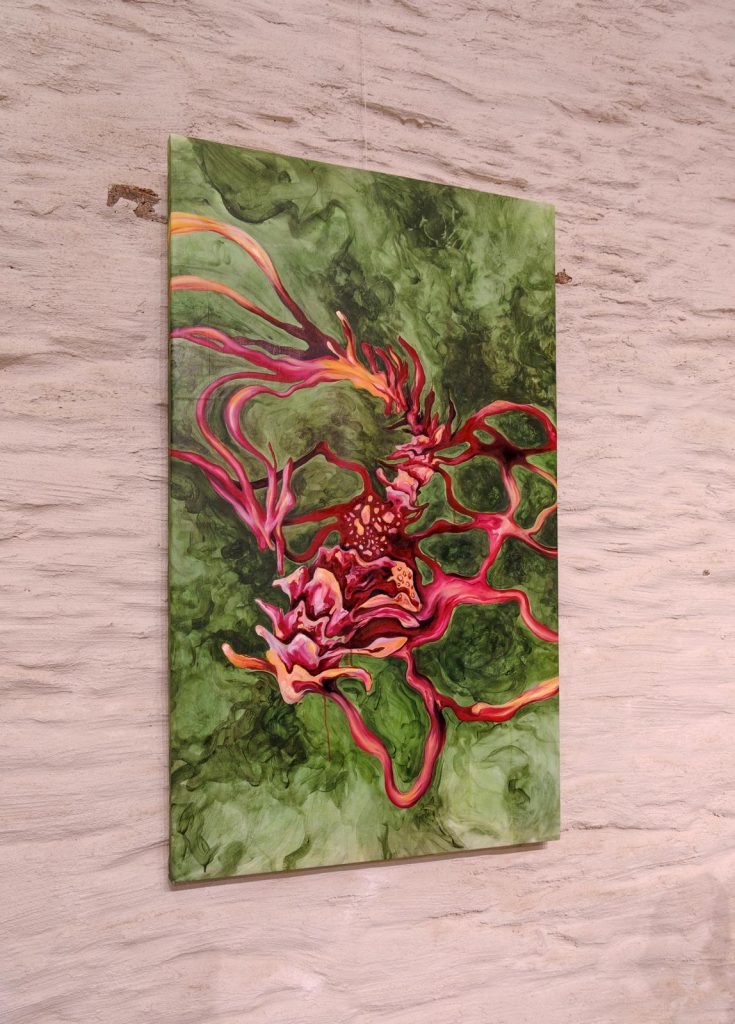Prepared by: Douri’s Empowring Creative minds team
Edited by: Jang Kapgen

©lesure.nathalie
Luxembourgish plastic artist, painter and curator Nathalie Lesure grew up surrounded by nature. For her, it is clear that art is also a product of its surroundings. Whether it is her immediate environment, her artistic community, or politics, it all has affected and continues to affect her artistic approach. Like mycelium, these connections and cross-contaminations are where new inspiration springs from. As part of the Empowering Creative Minds project, Douri asbl invited Lesure for an interview to speak about mushrooms, moss, and the language of art.
Douri: What key milestones have shaped your creative journey?
Nathalie Lesure: An important part of my creative journey was that I was lucky to meet Luxembourgish artists from early on. As a teenager, I spent most of my free time in artist studios. Being able to express myself outside of the conventional school system made me realize that art isn’t about rules, but rather about freedom and individuality. During my art studies in France, I joined several artist-run associations and I had a close-knit studio community. These spaces of mutual exchange and support challenged and nourished my path.

©lesure.nathalie
Today, I continue to search for dynamic networks and I’m currently a member of AAPL [Association des Artistes Plasticiens du Luxembourg] in Luxembourg. I don’t really believe in the myth of the isolated artist. We aren’t detached from the world. Our work is shaped by our environments, whether it be personal or political.
In what ways have your upbringing and personal experiences influenced your artistic direction?
I grew up in the countryside of northern Luxembourg, surrounded by dense forests. My childhood was tactile: I spent hours building makeshift forts, watching insects and moss, collecting bones. I let the non-human world guide my imagination. I grew up at the edge of the digital generation, so my attention was shaped more by the forest than by screens. That early closeness to nature gave me a different sense of time and taught me to notice small things.
My mother kept a medicinal plant garden, which introduced me to plants not just as materials, but as carriers of cultural memory. Learning how to use and care for them gave me a sense of independence from hyper-consumerist systems. All of this forms the base of my practice now. Whether I work with bones, plants or wood, I keep circling back to nature and its ecosystems, to care and grief.
Do you believe that art can express emotions and experiences that are hard to articulate in words?
I see art as a separate language: one that doesn’t have to pass through vocabulary, logic, or social codes. It can come from a place of instinct or emotion. Research and conceptual work are important, but for me, the core of an artwork needs to come from a place of honesty and connection. I’m especially drawn to pieces that trigger something physical in the viewer, a pause, a chill, a breath that suddenly slows down. Art can speak to parts of us that aren’t verbal. That’s where it becomes transformative.
What does it mean to you when your art resonates with or impacts others? Is this something you intentionally seek?

©lesure.nathalie
I really connect with the idea of resonance from Hartmut Rosa. He describes that we’re already in relation with the world, and what matters is when something "responds." When someone engages with my work and feels something, seen, unsettled, moved, it creates a shared moment. That’s when the piece becomes something more than just mine.
I don’t try to control how people respond, but I do try to leave space for others to project their own experience. If a memory, sensation, or new thought surfaces in someone, then I feel the work has done what it needed to do. Not as a fixed object, but as a kind of process that keeps unfolding.
How do you see the role of institutions – such as theatres, publishers, galleries, or museums in shaping the landscape of art and creativity?
Institutions should make art accessible: not just physically or economically, but in terms of care. That means recognizing that culture isn’t only intellectual. Our bodies, our intuition, our shared experiences all need space too. I think institutions also need to do more to question the elitist frameworks that still define a lot of the art world. It’s not just about showing work, but it’s about building trust, meeting communities eye to eye, and asking who the institution is really for.
In a time where everything feels fast and transactional, I believe cultural spaces can offer something slower and more grounded, a space for reflection, softness, or friction. Something that doesn’t always have to be consumed.
Are there any current or upcoming projects you’re excited about?
I’m currently working on projects about the cycle of life in nature and Northern European funerary rituals. I’m especially interested in the use of moss, roots, or fungal systems, as a way to think about healing and decay. I feel the need to talk about it in a world that often treats grief, whether personal or
planetary, as something to hide or fix.
Thank you Nathalie Lesure for this interview.
Conducted as part of the Empowering Creative Minds project, this interview offers just a glimpse into Nathalie’s world. You can learn more by visiting her website: https://nathalies-artbook.jimdofree.com/

©lesure.nathalie


